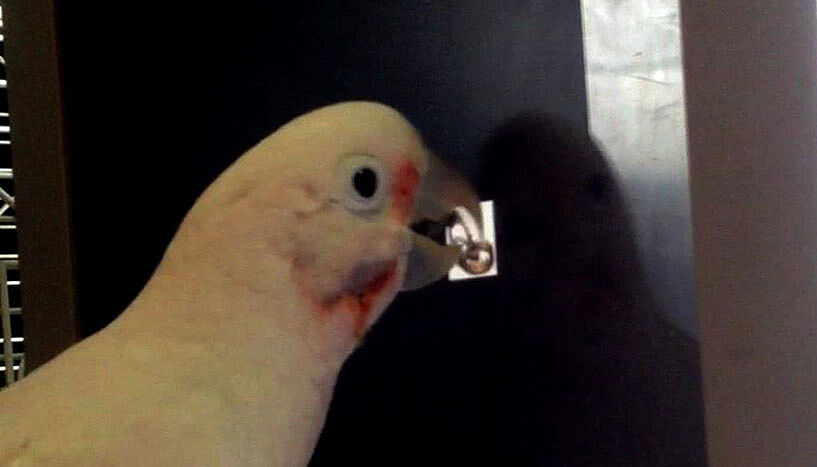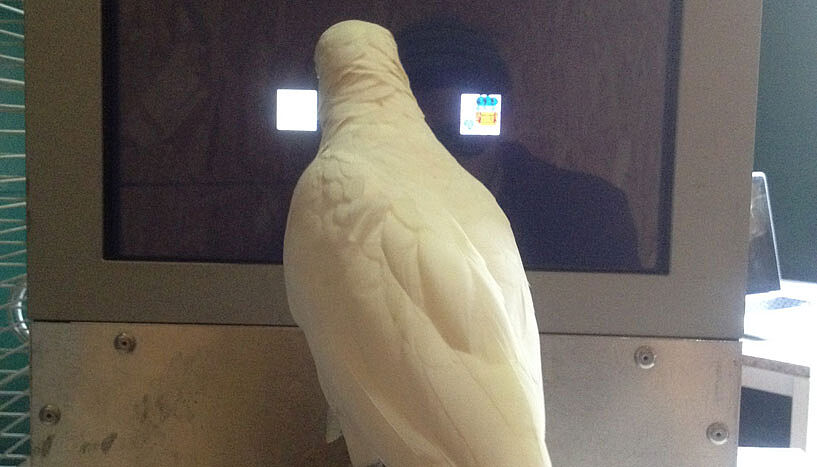Even cockatoos conclude
26. August 2015Smart cockatoos infer by exclusion
If there is a certain pool of choices (eg. A, B and C) and we can exclude A and B, we can easily deduce that C must be the appropriate choice. The ability of animals to be able to solve this sort of logical inference has been the focus of many studies in recent comparative cognitive research. However, only few managed to establish a comparatively applicable task. Especially highly investigative species may check out a new options simply out of curiosity, and are henceforth difficult to test with conventional methods. A team of researchers of the University of Vienna and the Messerli Research Institute at the University for Veterinary Medicine in Vienna have found a method and used a touchscreen computer to test if Goffin cockatoos have the ability to infere by exclusion. They publish their findings this week in the scientific journal PLoS One.
It can be challenging to develop a task setup to test inference by exclusion that can be applied in similar way to different species. One of the problems of previous studies was to exclude the possibility that animals chose a novel stimuli simply out of curiosity rather than by the exclusion of known negative stimuli. The use of the touchscreen presents a controlled setting to test cognitive capacities in animals and has already successfully been used in a number of species.
Goffin cockatoos are a highly curious Indonesian parrot species that have already proven to possess remarkable cognitive capacities. They possess high levels of ‘Neophilia’, which is the tendency of an individual to explore novel items and is believed to have evolved in species inhabiting islands, as there they might face fewer or no predators. In the current task, the Goffins had to learn to associate a picture with a reward that would be delivered automatically after they touched the picture on the touchscreen whereas the picture next to it would lead to no reward. During this training the unrewarded stimulus occasionally was replaced by novel, unknown stimuli. Only once the individuals chose reliably the positive stimulus over the negative or novel ones they were tested for their inference skills. This procedure ensured that the cockatoos would not choose novel pictures purely based on curiosity in the test.
In the following tests however, various combinations of novel and known pictures, which could be rewarded or unrewarded, were presented to the birds. Depending on how the individuals performed in this sequence of tests, allowed the researchers to tell apart other, strategies that may have used by the animals. "More than half of our cockatoos choose their pictures in a way that clearly indicates the ability of infer by exclusion about rewarded stimuli. However alternative strategies also play an important role in guided their choices", says Mark O'Hara who developed this task together with his colleagues.
"Considering the cockatoos capacities in previous tasks we actually expected that they would show inferences by exclusion, but this was the first test if we could detect this ability with our new task. That we could show this sort of reasoning, together with other strategies so nicely, lets us hope that the method will be applicable to many species and ultimately might help us to understand something about the evolution of this ability." He adds.
Further Information:
http://cogbio.univie.ac.at/labs-and-research-sites/goffin-lab/
Publication in "PLoS One":
O’Hara M, Auersperg AMI, Bugnyar T, Huber L (2015). Inference by Exclusion in Goffin Cockatoos (Cacatua goffini). PLoS ONE 10(8): e0134894.
Doi: 10.1371/journal.pone.0134894
Wissenschaftlicher Kontakt
Mag. Mark O'Hara
Abteilung für KognitionsbiologieUniversität Wien
1090 - Wien, Althanstraße 14
+43 650 980 6751
mark.ohara@univie.ac.at
Rückfragehinweis
Stephan Brodicky
Pressebüro der Universität WienUniversität Wien
1010 - Wien, Universitätsring 1
+43-1-4277-175 41
+43-664-60277-175 41
stephan.brodicky@univie.ac.at


